Alaska Rein Orchid
|
| Platanthera unalascensis |
Endangered (September 2013) |
| Alaska Rein Orchid is a perennial orchid, tall and slender in appearance with white flowers. It is of the “rein orchid type” and is inconspicuous outside of its flowering period. Its flowers are translucent green to white with leaves basal, gladiate and green. Its bracts are green to translucent green. The only known occurrence of this species in Newfoundland and Labrador is a very small locality near Port au Choix on the Great Northern Peninsula. Alaska Rein Orchid is typically found in Larch (Larix laricina) shrub swamps with low (3-5m tall) Balsam Fir (Abies balsamea) and Black Spruce (Picea mariana). |
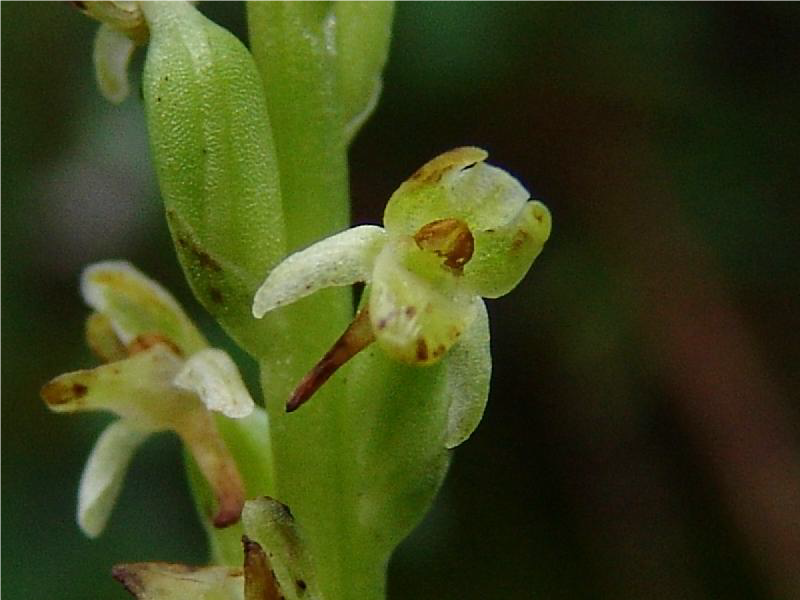 |
^ Top of Page
Barrens Willow
|
| Salix jejuna |
Endangered (July 2002) |
| Barrens willow, also known as barren willow, insignificant willow, and Belle Isle dwarf willow, is a dwarf, prostrate shrub with small, rounded, hairless leaves with a waxy upper surface. Barrens willow grows in a narrow band of limestone barrens stretching along the coast northwest coast near the tip of the Great Northern Peninsula. This plant has never been found anywhere else in the world; it is one of a unique set of species adapted to the harsh climate conditions and natural processes that characterize the coastal limestone barrens of the Strait of Belle Isle. |
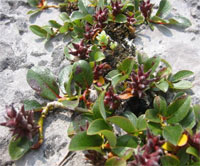 |
^ Top of Page
Black Ash
|
| Fraxinus nigra |
Threatened (July 2021) |
| Black Ash is a small, slow-growing, deciduous tree species. Bark is light gray in colour and becomes spongy with curly ridges as the tree ages. Branches are stout and oppositely-arranged with pinnately compound leaves that contain between 7 and 11 leaflets. Terminal buds are, distinctively, ‘chocolate-chip’ shaped in appearance. In Newfoundland, individual trees are rarely taller than 10 m, and a multi-stemmed, shrub-like growth form is common in trees that have experienced significant herbivory or other mechanical damage. The species typically occurs in areas with rich, moist soils (e.g., bogs, flood plains, swamps, and stream banks), and occasionally on steep, limestone talus slopes. Photo Credit: Susan Meades |
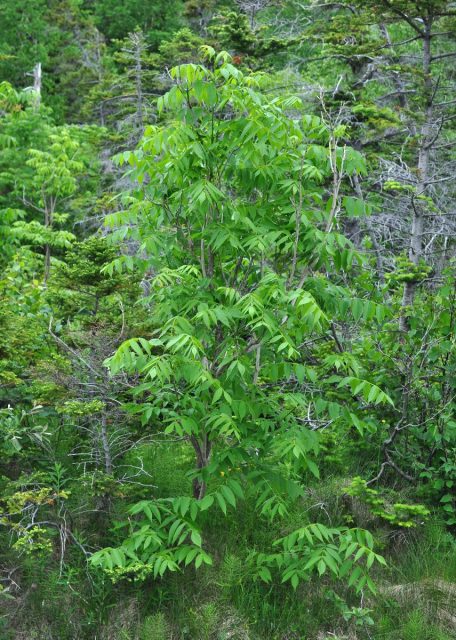 |
^ Top of Page
Blue Felt Lichen
|
| Pectinia plumbea (= Degelia plumbea) |
Vulnerable (April 2015) |
| Blue Felt Lichen is a large, blue-grey, leafy lichen that is fairly robust and clings tightly to its substrate. This lichen grows most often on yellow birch in moist sites, and more rarely on trembling aspen, white spruce, or rock. It has also been found on non-native trees. In Canada, this species is also found in New Brunswick and Nova Scotia. In Newfoundland and Labrador, this species is known to approximately 24 locations on the Island within four general areas: the Bay D’Espoir area, the central Avalon Peninsula, Terra Nova National Park, and southwest Newfoundland. |
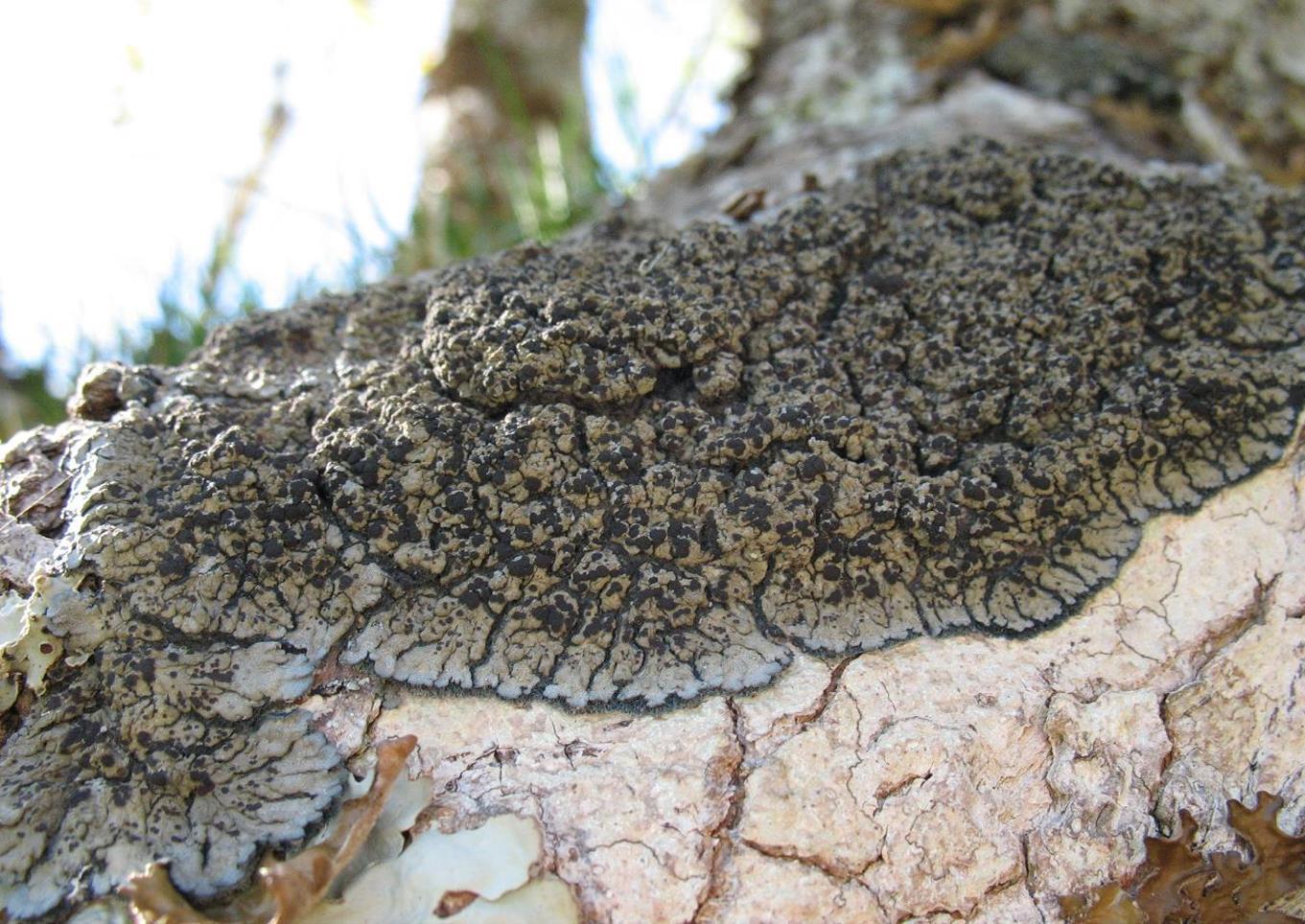 |
^ Top of Page
Bodin’s Milkvetch
|
| Astragalus bodinii |
Threatened (September 2013) |
| Bodin’s Milkvetch is a weak-stemmed perennial herb with a free-branching, carpet-forming growth pattern that emerges from its taproot. The species bears showy, pinkish-blue, pea-like flowers with pinnately-divided leaves. Bodin’s Milkvetch is found in only one extremely restricted locality near Cook’s Harbour, Newfoundland. Relatively widespread in western North America, Bodin’s Milkvetch appears to inhabit a reasonably varied, mostly upland habitat, with elevations ranging between 300-3,000m. In Newfoundland, however, the species appears to occupy a unique coastal habitat. |
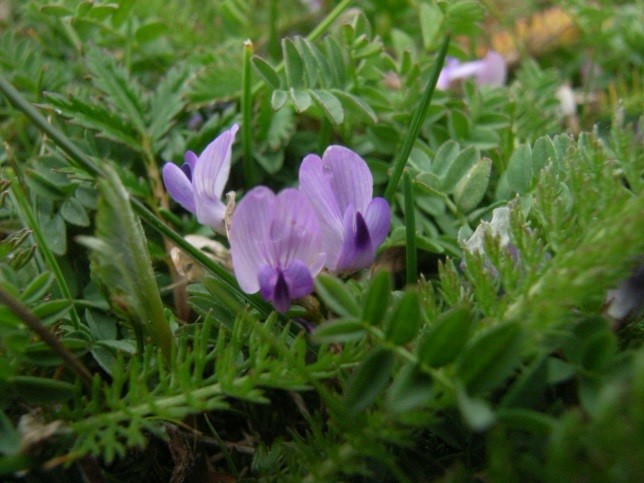 |
^ Top of Page
Boreal Felt Lichen
|
| Erioderma pedicellatum |
Vulnerable (July 2002) |
| Boreal felt lichen is an epiphytic lichen that grows on trunks and branches of trees, mostly balsam fir. Its leafy thallus is gray on the upper surface and white underneath, and its colour changes to greenish when wet. The edges of the thallus curl upward, giving the lichen a unique, white-fringed appearance when viewed from a distance. Its distinctive fruiting bodies look like reddish-brown warts on the upper surface.
Boreal felt lichen is the only boreal member of an otherwise tropical group of lichens of very ancient origin. It is very rare in Scandinavia and Nova Scotia, and has recently been discovered in Alaska. It appears the species has been extirpated from New Brunswick, and the number of sites has drastically declined Nova Scotia. Newfoundland has over 90% of the known global population and the health of the Newfoundland population is pivotal to the survival of the species. This species grows in sub-oceanic forest regions of insular Newfoundland and is concentrated in two areas, the central Avalon Peninsula and Bay d’Espoir. It has been declining at all monitored sites in both areas. In addition, boreal felt lichen is sensitive to air pollution and can be an excellent indicator of air quality. |
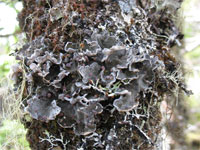 |
^ Top of Page
Crowded Wormseed Mustard
|
| Erysimum coarctatum (= Erysimum inconspicuum var. coarctatum) |
Endangered (November 2007) |
| Crowded wormseed mustard is a yellow-flowered, biennial or short-lived perennial herb in the mustard family. It has narrow leaves and long, narrow seed pods. Mature plants can range in size from 5 cm tall to 75 cm tall depending on soil moisture and nutrient status. There is only one known population in Newfoundland and Labrador, between the Bay of Islands and Gros Morne National Park on the western coast of the Island of Newfoundland. There were about 100 mature (flowering) plants at this site in 1995. In August 2000 no plants were seen, but in 2009 approximately 20 plants were counted. |
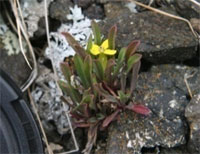 |
^ Top of Page
Cutleaf Fleabane
|
| Erigeron compositus |
Endangered (September 2013) |
| Cutleaf Fleabane is a low, often tufted semi-woody, tap-rooted perennial with a thick caudex. In Newfoundland, the tansy-like flower heads are solitary at the ends of the stems and rayless. The species can be found in a very small area along the lower Humber River on a talus slope between Corner Brook and Steady Brook. In addition, there are two transplant sites: one at the Marble Mountain quarry and the other at the Humber River gravel pit. Cutleaf Fleabane is an arctic-alpine plant often found in calcareous soils. In Newfoundland, the species prefers dry, gravelly or boulder-limestone substrate associated with scree, within open-to-sparse vegetation. |
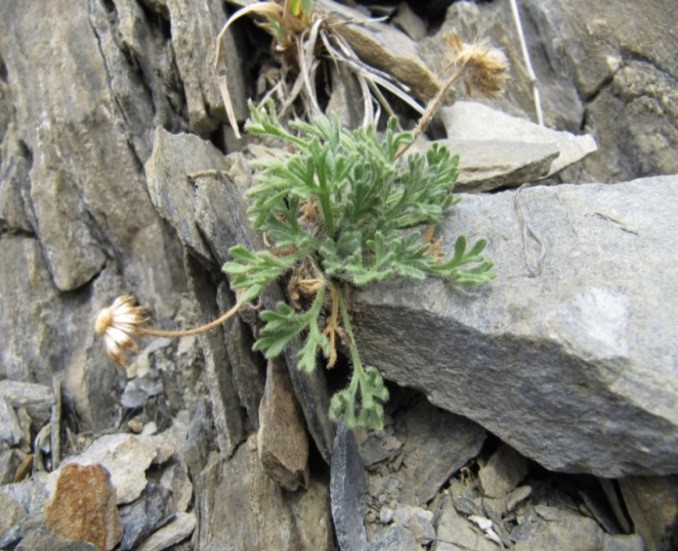 |
^ Top of Page
Dense Draba
|
| Draba pycnosperma |
Vulnerable (June 2023) |
| Dense Draba is a small, perennial plant that grows in clumps on cliffs and rock outcrops. The species produces white flowers (May to June; 5-40 per stalk) and seeds are dispersed by wind. The total number of individual plants is believed to be less than 3,000. Dense Draba is found nowhere in the world other than Newfoundland and Labrador, and Québec. Photo Credit: Frederic Coursol |
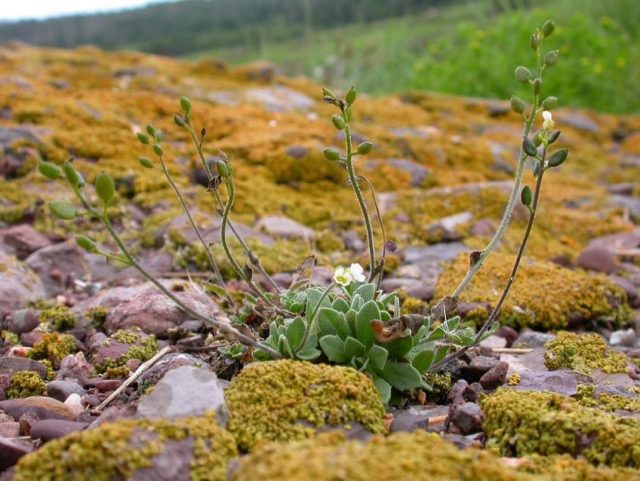 |
^ Top of Page
Feathery False Solomon’s Seal
|
| Maianthemum racemosum |
Endangered (September 2013) |
| Feathery False Solomon’s Seal is an arching, lily-like plant which closely resembles, though is not actually closely-related to, the garden variety Solomon’s Seal. The species can attain heights of up to 125cm and contains 70-250 small, star-like white flowers in a concentrated terminal array. Its leaves are green, alternate and petioled in addition to gladiate and oblanceolate. When young, berries are green with copper spots and then mature through a “pinkish” stage to a deep translucent red. Feathery False Solomon’s Seal is found in only three small areas on the west coast: Mollichignick Brook, Trout River Ponds and the southwest slope of the Lewis Hills (historical). The species can be found in deciduous woods in addition to shaded roadsides and urban and suburban wood tracts. It is typically found in the elevation range of 0-800m. |
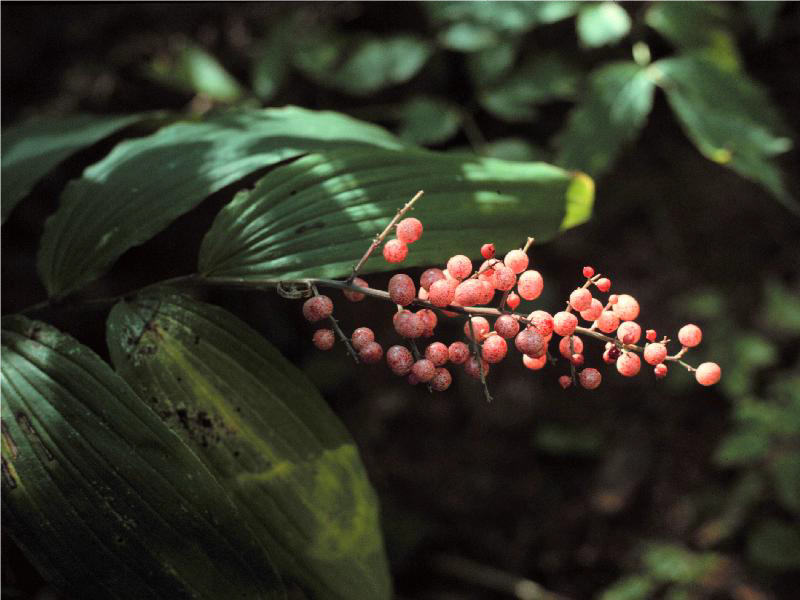 |
^ Top of Page
Fernald’s braya
|
| Braya fernaldii |
Endangered (June 2016) |
| Fernald’s braya is a small, perennial plant of the mustard family. It has a deep taproot; a rosette of fleshy, linear to spatulate leaves; and erect, flowering stalks, up to seven centimeters high. Its four-petaled flowers are white to pink. The fruit is an elongate, usually hairy, capsule. It is generally smaller than Long’s braya, with hairier fruits. Fernald’s braya is endemic to the northwest coast of the Great Northern Peninsula, and is restricted to the narrow band of limestone barrens found along the coast. This plant has never been found anywhere else in the world. It is one of a unique set of species adapted to the harsh climate conditions and natural processes that characterize the coastal limestone barrens of the Strait of Belle Isle. |
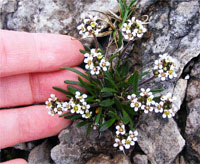 |
^ Top of Page
Fernald’s Milk-Vetch
|
| Astragalus robbinsii var. fernaldii |
Vulnerable (July 2002) |
| Fernald’s milk-vetch is a perennial, herbaceous plant that grows in small clumps. It is a member of the pea and bean family. Its alternate leaves are compound, with nine to 17 hairy leaflets. Flowering stalks borne along the stem bear 10-20 small flowers, which are purple to lilac in colour and fruit that is a hairy and on a short stalk. Fernald’s milk-vetch is known to occur only from the Strait of Belle Isle region of the Gulf of St. Lawrence. Most of its known population occurs in the Blanc Sablon area of Québec and the adjacent area of southeastern Labrador. A recently rediscovered, disjunct population of milk-vetch from the highlands of St. John on the Northern Peninsula is now thought to be the closely related Robbins’ milk-vetch. Fernald’s milk-vetch grows in exposed, calcareous habitats with low heath vegetation. |
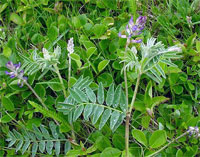 |
^ Top of Page
Gmelin’s Watercrowfoot
|
| Ranunculus gmelinii |
Endangered (April 2015) |
| Gmelin’s Watercrowfoot is a small aquatic plant of shallow river backwaters with a muddy bottom. Its leaves form mats underwater and its small, yellow buttercup-like flowers project out of the water. In Newfoundland and Labrador, it is known from only one location on the west coast of the Island near the Robinson’s River. |
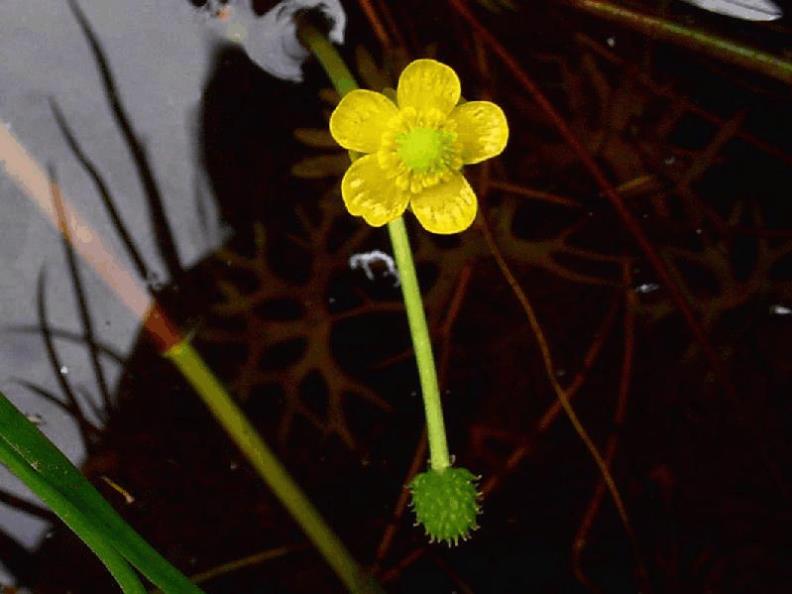 |
^ Top of Page
Graceful Felt Lichen
|
| Erioderma mollissimum |
Endangered (March 2013) |
| Graceful Felt Lichen is a foliose macrolichen appearing grey-brown when dry and brownish-green when wet. It has a felty upper surface and its thallus can extend up to 12cm wide. The thallus is composed of radiating, loosely-attached lobes up to 1cm wide which are rounded with upturned edges. On the upper lobe surface, there is a distinct tomentum (fine hairy covering) and soredia (granular asexual reproductive structures) are found on older thalli on the lobe margins and scattered in clusters on the upper surface. The first E. mollissimum in Newfoundland was discovered in 2006 at a site west of Ninth Fox Pond close to Halls Gullies. As of 2018, a range of 55-84 thalli are confirmed to exist on 12 trees at twelve sites on the Avalon Peninsula. Graceful Felt Lichen is generally found in humid forests. In Newfoundland, the species can be found in stands dominated by Balsam Fir (Abies balsamea) in mature or uneven-aged coniferous forests on gentle, well-drained to imperfectly-drained slopes. |
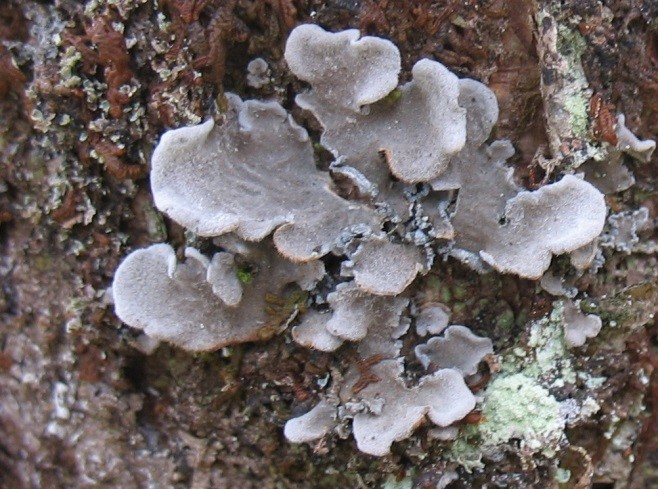 |
^ Top of Page
Griscom’s Arnica
|
| Arnica griscomii subsp. griscomii |
Endangered (April 2015) |
| Griscom’s Arnica is a member of the sunflower family with toothed oval to egg-shaped leaves and produces one single yellow, daisy-like flower head per stem. It is most often found on limestone on ledges of partially shaded cliffs. This subspecies is endemic to the Gulf of St. Lawrence region and is found only on the Island of Newfoundland and in Québec. In Newfoundland and Labrador, it is known to occur at only three locations on the west coast of the Island. |
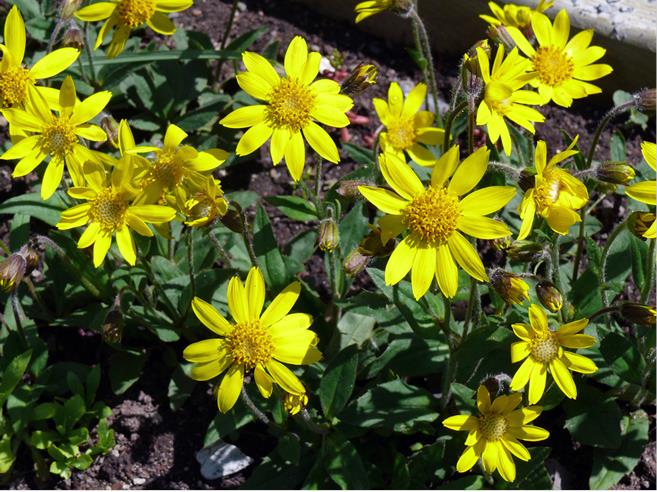 |
^ Top of Page
Lindley’s Aster
|
| Symphyotrichum ciliolatum |
Endangered (September 2013) |
| Lindley’s Aster is a medium-sized perennial aster ranging in height from 30-100cm, arising from elongate herbaceous rhizomes. Its flowers are purple-blue and basal leaves have broad, shallowly-cordate blades which typically winter by the time the species flowers. Lindley’s Aster is found in the Stephenville-St. George’s Bay area in addition to a broad locality on the central portion of the Port au Port Peninsula. The generalized habitat of Symphyotrichum ciliolatum encompasses rich, open and often calcareous boreal deciduous forests (Aspen or Aspen-Birch-Fir-Spruce). Other habitats include: clearings, edges of woods, Aspen or Oak thickets, open Pine forests, trails, streambanks and roadsides. Elevations range from 0-2,000m+. |
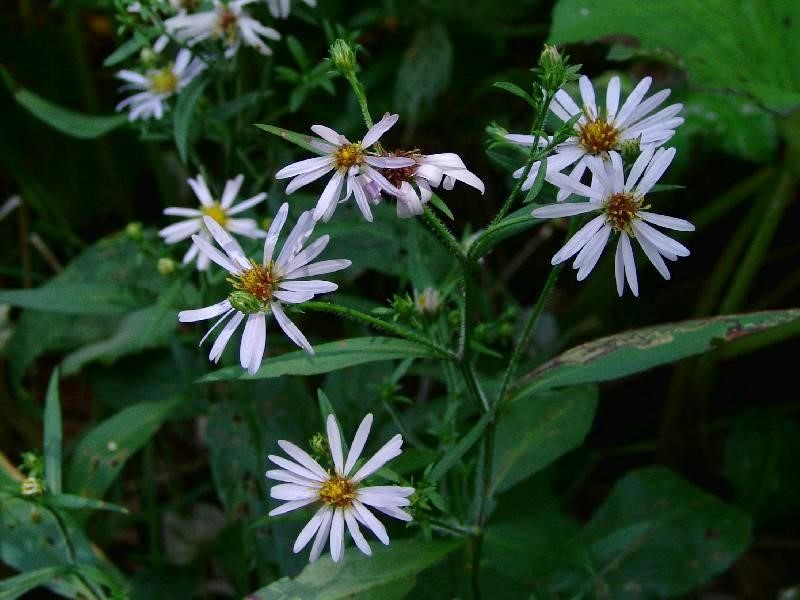 |
^ Top of Page
Long’s Braya
|
| Braya longii |
Endangered (July 2002) |
| Long’s braya is a small perennial plant that is a member of the mustard family. It has a deep taproot, a rosette of fleshy, linear leaves, and erect flowering stalks up to 10 cm high. Its four-petalled flowers are white with a tinge of violet. The fruit is an elongate, usually hairless, capsule. Long’s braya is endemic to the northwest coast of the Great Northern Peninsula, and is restricted to several small populations in a narrow band of limestone barrens found along the coast. This plant has never been found anywhere else in the world. It is one of a unique set of species adapted to the harsh climate conditions and natural processes that characterize the coastal limestone barrens of the Strait of Belle Isle. |
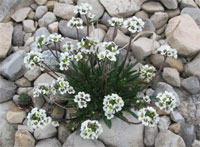 |
^ Top of Page
Low Northern Rockcress
|
| Neotorularia humilis (= Braya humilis) |
Endangered (December 2004) |
| Low northern rockcress is a small, perennial herbaceous plant in the mustard family. It grows to about 10 cm tall and has small white flowers. Unlike the two braya species, to which it is closely related, the flower stalks can be branched. The low northern rockcress was discovered in Newfoundland in 1914 and is still only known from one location on the west coast of the island, where it lives on limestone barrens found on exposed mountain ridges. |
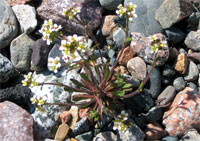 |
^ Top of Page
Mackenzie’s Sweetvetch
|
| Hedysarum boreale subsp. mackenzii |
Threatened (May 2022) |
| Mackenzie’s sweetvetch is a perennial plant of the pea family. It irregular shaped, pea-like purple flowers are sweet scented and occur in small clusters. In the province of Newfoundland and Labrador Mackenzie’s sweetvetch is only found at two sites separated by about 7 km on the west coast of the Port au Port Peninsula. It is restricted to open limestone barrens. A total of approximately 300 to 1000 individuals is estimated to occur at the two sites. |
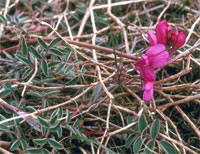 |
^ Top of Page
Mountain Bladder Fern
|
| Cystopteris montana |
Endangered (June 2016) |
| Mountain Bladder Fern is a low-growing fern with triangular leaves up to 30 centimeters tall that arise from growing tips of long, thin underground stems. This fern grows on the ground in wet woodlands or along watercourses, and occurs in the cool climates of North America, Greenland, Europe and the high mountain areas of central and eastern Asia.
Mountain Bladder Fern is thought to be rare due to low reproductive rates and poor establishment success. Only one Mountain Bladder Fern site is known on the Island of Newfoundland. It is located on the Great Northern Peninsula, on the eastern side of Yankee Point, at the edge of the community of Savage Cove. Mountain Bladder Fern was first discovered in 1924 and was still found at the site in 2007. |
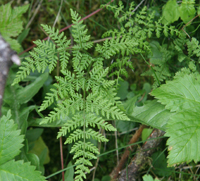 |
^ Top of Page
Mountain Fern
|
| Oreopteris quelpartensis (= Thelypteris quelpaertensis) |
Vulnerable (November 2007) |
| The mountain fern can reach heights of 75 cm. It produces stolons and forms large colonies by vegetative reproduction. It is found in moist, open subalpine meadows, beside lake shores, brooks, and springs. The only population in Canada east of the Rockies is found in western Newfoundland, on the Long Range plateau within Gros Morne National Park. |
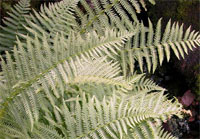 |
^ Top of Page
Northern Bog Aster
|
| Symphyotrichum boreale |
Endangered (August 2010) |
| The northern bog aster is a member of the Aster family that can reach heights of 80 cm and has white to pale bluish flowers arranged in a short, broad cluster. The only known location for this species in the province of Newfoundland and Labrador is a fen at Wild Cove, near Corner Brook. The population is estimated to be between several hundred individuals. |
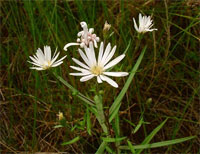 |
^ Top of Page
Northern Twayblade
|
| Neottia borealis (= Listera borealis) |
Endangered (June 2016) |
| Northern Twayblade is a small, less than 20 cm high perennial orchid with one small pair of oval to egg-shaped leaves that are directly attached to the stem without a leaf stalk. In this province, Northern Twayblade is currently known to only two small locations on the Island of Newfoundland: Lomond, in Gros Morne National Park and at Eddie’s Cove East, where it was recently discovered. The total population in the province is estimated at a maximum of 81 mature plants. |
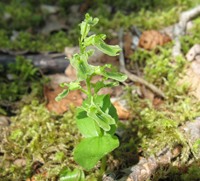 |
^ Top of Page
Oval-leaved Creeping Spearwort
|
| Ranunculus flammula var. ovalis |
Endangered (September 2013) |
| Oval-leaved Creeping Spearwort is a small, amphibious, trailing buttercup. It is a perennial plant with small yellow flowers and short, thick leaves which are narrowed at the base and more expanded and pointed towards the tip. Oval-leaved Creeping Spearwort is only present on the Great Northern Peninsula in Port au Choix, Sandy Cove, Point Riche and St. John Island. In Newfoundland, the species is typically found near sea level and is restricted to intermittent pools found in exposed portions of limestone barrens. All limestone barrens habitat in Newfoundland where Oval-leaved Creeping Spearwort has been found have been slight, intermittently-wet depressions. |
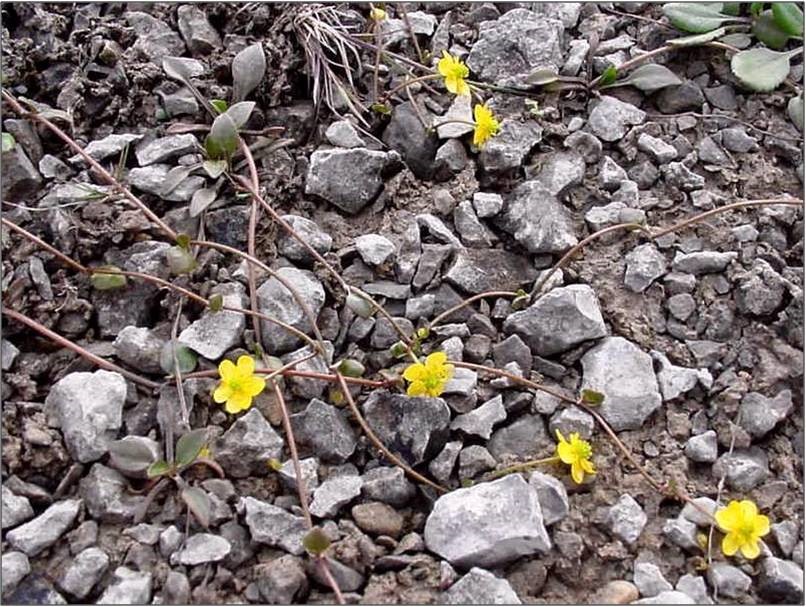 |
^ Top of Page
Porsild’s Bryum
|
| Haplodontium macrocarpum (= Mielichhoferia macrocarpa = Bryum porsildii) |
Threatened (December 2004) |
| Porsild’s bryum is a tiny moss occurring mostly in arctic or alpine climates. The six known locations in our province are all clustered near the tip of the Great Northern Peninsula and represent just over half of the Canadian total. Populations are scattered colonies on rock faces which can, at times be unstable. It is possible for rock slides to destroy an entire population. |
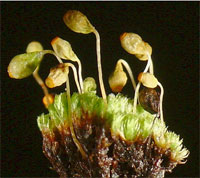 |
^ Top of Page
Rattlesnakeroot
|
| Nabalus racemosus (= Prenanthes racemosa) |
Endangered (August 2010) |
| Rattlesnakeroot is a perennial plant with drooping pink, purplish or white flowers. The stem secrets a milky juice. The only known location for this species in the province of Newfoundland and Labrador is a fen at Wild Cove, near Corner Brook. The total population is estimated at several hundred to several thousand individuals. |
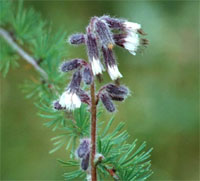 |
^ Top of Page
Red Pine (Natural Populations)
|
| Pinus resinosa |
Threatened (May 2022) |
| Red Pine is Newfoundland’s rarest conifer species. It is an eastern hard pine with evergreen needles in bundles of 2 that are 7 to 17 cm long, straight, brittle, pointed, and sharply-toothed. Bark becomes progressively scaly with age, and furrows into broad, scaly plates that are reddish to pinkish in colour. Natural Red Pine stands are known to three disjunct areas of Newfoundland, the Sandy Lake, Exploits, and Bonavista Bay regions; it is believed that the species once had a much wider distribution. Recent estimates (2010) suggest that the natural (non-planted) population consists of approximately 15,000 individuals. Photo Credit: Susan Meades |
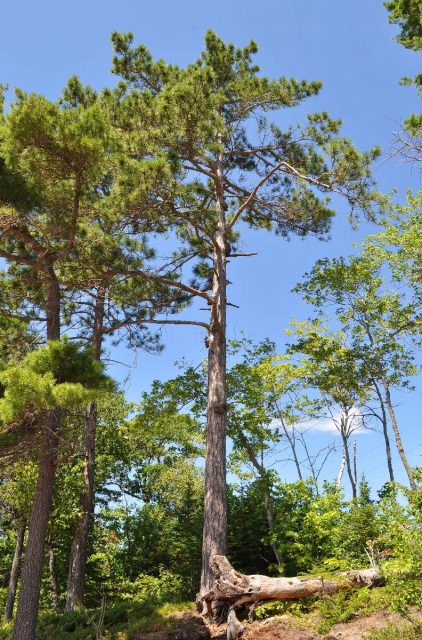 |
^ Top of Page
Rock Dwelling Sedge
|
| Carex petricosa var. misandroides |
Endangered (September 2013) |
| Rock Dwelling Sedge, a species of the sedge, is loosely-cespitose with long slender rhizomes. The misandroides variant can be distinguished from the petricosa variant by its culms (up to 50cm), stigmas (mostly 2) and the achenes (biconvex in at least half of the pistillate flowers and fruit). Rock Dwelling Sedge is found from only 5 small localities on the west coast: Cape St. George, Table Mountain, William Wheeler point (extant), Woman Cove and Shag Cliff (Bonne Bay). Rock Dwelling Sedge can typically be found on limestone barrens, taluses, screes, cliffs and shores at elevations ranging from 0-300m. In Newfoundland, the species inhabits dry to damp limestone cliffs, tableland and barrens, slippery talus slopes and the upper parts of scree slopes. It can be found growing in gravel mixed with fine soils, over bedrock or rubble and sometimes on mossy knolls with small isolated shrubs such as Dasiphora fruticosa, Juniperus communis and Betula papyrifera. |
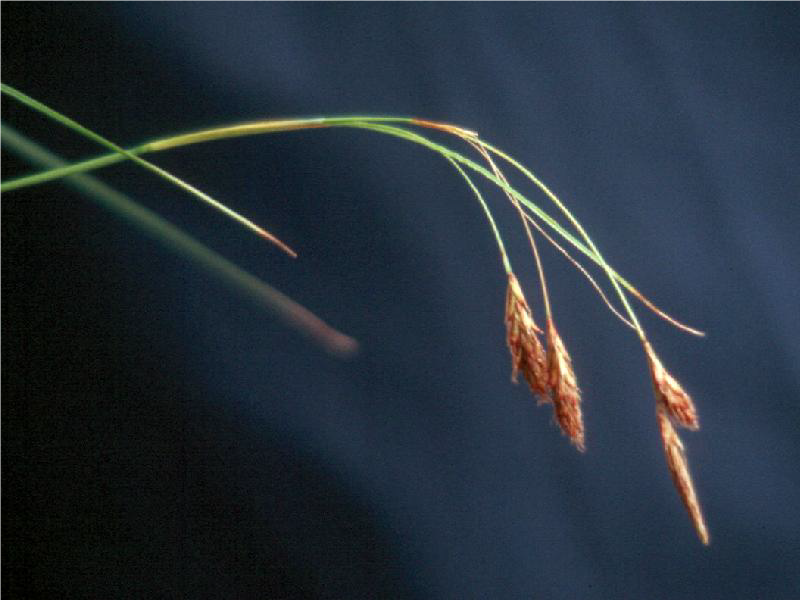 |
^ Top of Page
Sharpleaf Aster
|
| Oclemena acuminata |
Threatened (April 2014) |
| Sharpleaf Aster is an inconspicuous white-flowered aster with upper leaves that are found in a whorl distributed around the stem. This plant flowers in late summer and early fall. Sharpleaf Aster is found in shaded woodland habitats. In Newfoundland and Labrador, it is only currently known from J.T. Cheeseman Provincial Park. |
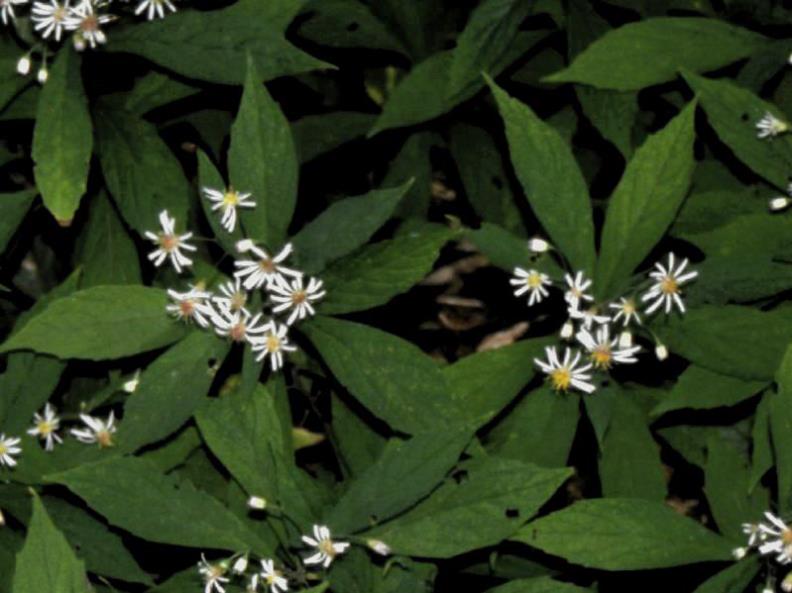 |
^ Top of Page
Tradescant’s Aster
|
| Symphyotrichum tradescantii |
Threatened (April 2015) |
| Tradescant’s Aster is a small, perennial aster with an open, branched flower cluster that produces five to six small, white daisy-like flower heads. It is a plant of shoreline habitats that can survive periods of complete inundation in wet years. The species is endemic to eastern North America and also occurs in Nova Scotia, New Brunswick and Québec. In Newfoundland and Labrador there is only one known current location on the west coast of the Island, near the head of St. George’s Bay. |
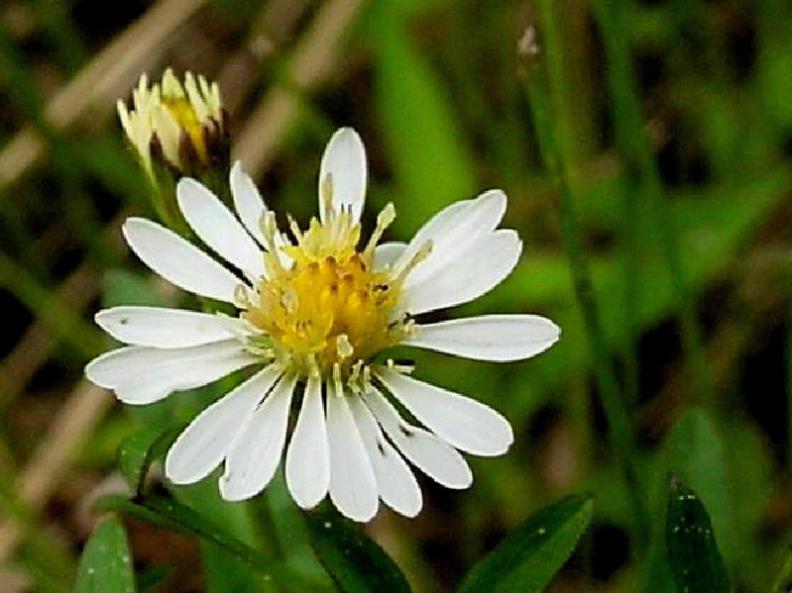 |
^ Top of Page
Vreeland’s Striped Coralroot
|
| Corallorhiza striata var. vreelandii |
Endangered (September 2013) |
| Vreeland’s Striped Coralroot is a terrestrial, perennial orchid. It is categorized as achlorophyllous, appearing yellowish in its overall appearance. Its height ranges from 10-44cm tall, with leaves reduced to several small bracts attached to tubular basal sheaths. In a raceme, up to 28 flowers are borne, which are a dull yellow color with longitudinal magenta stripes. The flower stalks typically grow in dense clumps with a clubbed and coralloid rhizome. The species can be found in 2 areas on the island, both north of Deer Lake on the west coast: Lomond, Gros Morne National Park and Cormack Road, Cormack. At both localities in Newfoundland, Vreeland’s Striped Coralroot inhabits semi-open, second-growth forests of Balsam Fir (Abies balsamea), Black Spruce (Picea mariana), Eastern Larch (Larix laricina), Speckled Alder (Alnus incana subsp. rugosa), Balsam Poplar (Popular balsamifera) and Mountain White Birch (Betula cordifolia). |
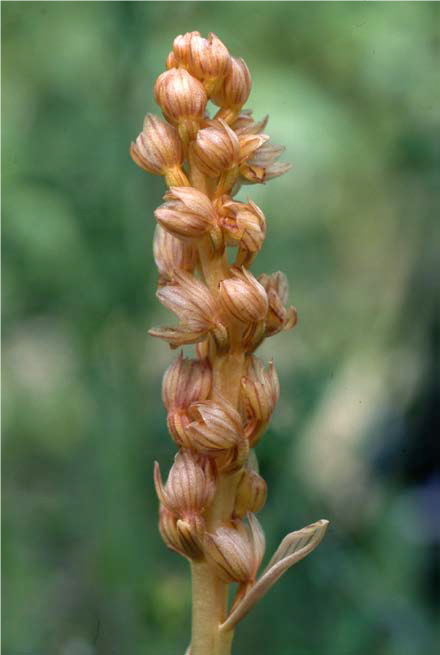 |
^ Top of Page
Water Pygmyweed
|
| Tillaea aquatica |
Vulnerable (April 2015) |
| Water Pygmyweed is a tiny semi-aquatic, succulent annual plant that often grows in mats; the plants are so small that 1,000 individuals could grow within a square meter. It often appears reddish in colour and produces tiny white flowers. This species grows on sandy shores of rivers or ponds and sandy margins of vernal pools in coastal areas with a distinct marine influence. This species has been recorded in other provinces. In Newfoundland and Labrador, there are six known locations of Water Pygmyweed on the Avalon and Burin Peninsulas. |
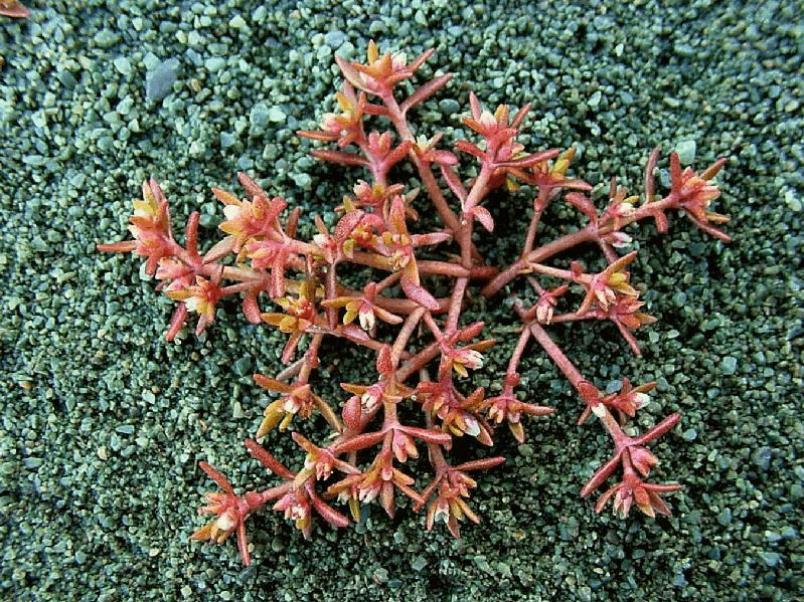 |
^ Top of Page
Wooly Arnica
|
| Arnica angustifolia subsp. tomentosa |
Endangered (April 2015) |
| Wooly Arnica is a member of the sunflower and produces one single yellow daisy-like flower head per stem. It has long, narrow leaves and the entire plant is covered with wooly hairs. The species most often grows in small clusters on limestone and has limited ability to multiply or colonize new areas. In Newfoundland and Labrador, it is currently known to only two locations near Port au Choix and the western Port au Port Peninsula. |
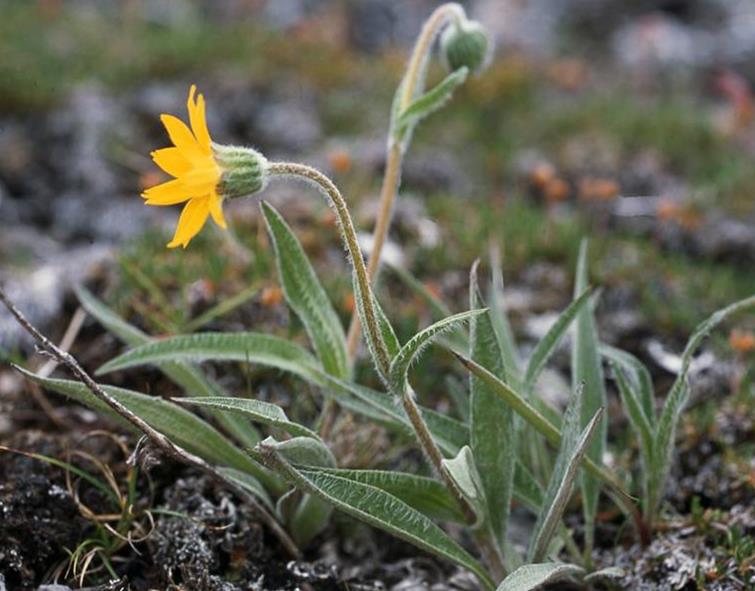 |
^ Top of Page
Wrinkled Shingle Lichen
|
| Pannaria lurida |
Threatened (July 2021) |
| Wrinkled Shingle Lichen is a foliose lichen that forms patches up to 10 cm across. The upper surface is brownish-grey in colour and wrinkly in texture. Apothecia (reproductive structures) are raised above the thallus surface, are red-brown in colour, and tend to have bristle-like hairs around the base. Throughout much of its range, the species grows on the trunks of deciduous trees; however, in Newfoundland it is known to a single cliff-side area in the Codroy Valley, where it grows on the trunk and branches of White Spruce trees. Recent estimates suggest the provincial population consists of between 30 and 100 thalli. Photo Credit: Susan Meades |
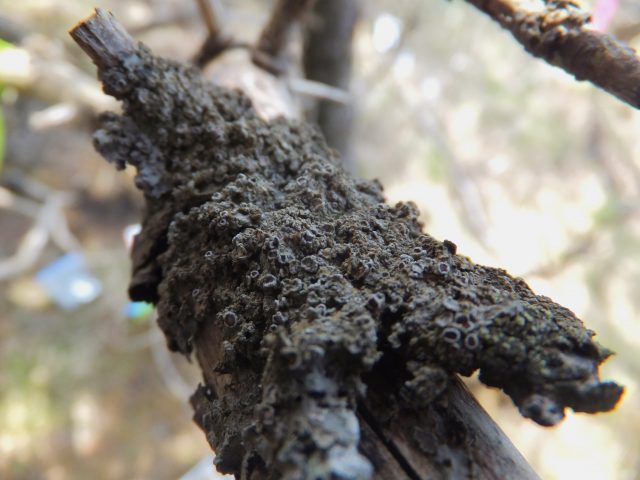 |
^ Top of Page
Adobe® Acrobat® Reader software can be used for viewing PDF documents. Download Acrobat® Reader for free.


































